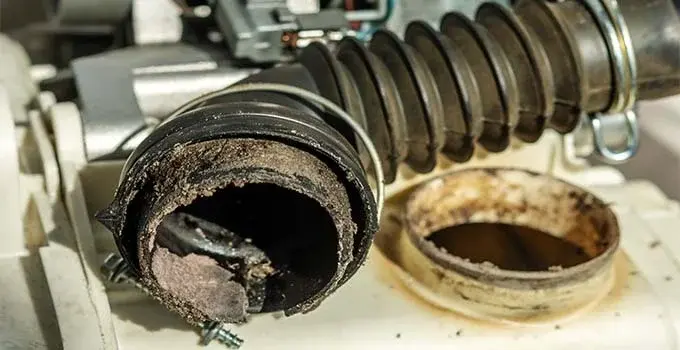
Cleaning air ducts is essential to keep your HVAC system
efficient. Many homeowners overlook this task, but it's vital to ensure the air
quality at home. Dust, dander, dirt, and even bug fragments can accumulate,
potentially affecting those with allergies.
Things You'll Need to Clean Your Air Ducts
To do the job effectively, you'll need the right tools: a new furnace filter, gloves, a mask, goggles, a vacuum with a powerful hose, a brush, a drill, cleaning cloths, and paper towels. These items are essential for a thorough clean, so make sure you have an ample supply.
Step-by-Step Duct Cleaning
So, let's dive into some easy DIY steps to get your ducts clean.- Turn Off Your Heating and Cooling
Before starting, ensure your thermostat is switched off. This is the safest way to begin since working with live power isn't efficient. It's smart to leave the fan running initially, as this helps with airflow, making it easier to dislodge and move the dust that's settled inside.
- Cover the Supply Vents
There are different vents in your home's HVAC system: supply vents channel air into rooms, while return vents cycle it back. Covering the supply vents prevents dust from re-entering the air ducts during cleaning. Use cloths or paper towels to cover these vents, ensuring the cleaning process stays tidy.
- Clean the Grilles and Vents
Cleaning the grilles and vents involves a few steps. Start by unscrewing the grille with a screwdriver and use a brush to dislodge dirt. Next, use a vacuum with a tube attachment to reach inside the duct. Follow up by wiping with a cloth and washing the grille to remove any stubborn dirt.
- Clean the Furnace and Fan
Once you've addressed the grilles and ducts, it's time to focus on the furnace and fan system. Make sure the power is turned off. Use a vacuum to remove dust from visible parts. If necessary, use a cloth for hard-to-reach areas. Don't forget to replace the filter with a new one to ensure optimal performance.
- Replace Your Air Filters
After cleaning the air ducts, it's crucial to swap out old filters with fresh, new ones. This helps maintain indoor air quality, keeping your HVAC system running smoothly.
- Replace the Grilles and Vent Covers
Once done, reattach the grilles, dispose of used paper towels, and reset the floor registers. Make sure everything is back in place before moving on.
- Reset the Thermostat
Finally, switch your system back on by setting the thermostat to the desired cooling or heating cycle. Now, you're ready to enjoy a cleaner airflow at home!
DIY Duct Cleaning: Tools and Costs
When tackling DIY air duct cleaning, understanding the potential costs and equipment you'll need is crucial. While some homeowners might think that cleaning their air ducts is a complex task, with the right tools and a bit of know-how, it can be quite manageable and economical. To get started, you'll need some basic tools: a vacuum with a long hose for reaching inside the ducts, a sturdy brush for scrubbing, a screwdriver for opening vent covers, and protective gear such as gloves and a mask to keep yourself safe from dust and debris. These effective, professional-grade tools ensure that you can do a thorough job, much like the pros.What are the Estimated Costs for DIY Air Duct Cleaning?
If you decide to clean your air ducts yourself, the expenses can be surprisingly minimal. Typically, homeowners spend anywhere between $50 and $200. This range covers all the necessary tools a vacuum with a long hose, brushes, and various cleaning agents. These items are essential for effective cleaning and are very economical compared to hiring professionals.
It's important to note, though, that while upfront costs are lower, incomplete cleaning could lead to further expenses. Issues like mold growth or accumulated debris can necessitate future repairs to your HVAC system, potentially eroding some of the initial savings.
Are There Long-Term Savings with DIY Cleaning?
By maintaining your air ducts with regular cleaning, you can certainly experience savings. These come in the form of reduced energy bills and fewer HVAC repairs. However, inadequate cleaning can cause significant issues, like decreased system efficiency or worsening allergy problems, which might require costly professional intervention. Thus, investing in cost-effective, quality tools and dedicating enough time to the task are key for both health and comfort.
Thinking About Cleaning Your Air Ducts Yourself?
Here's what you should know about the benefits and drawbacks.Pros of DIY Air Duct Cleaning
Many homeowners see DIY air duct cleaning as an effective way to save money, especially when hiring a professional can cost hundreds of dollars. By taking a DIY approach, you can purchase basic supplies for around $20, allowing for cost savings. This also gives you the flexibility to clean at your own pace and the satisfaction of handling the cleaning process yourself, keeping the task under your control and possibly improving your indoor air quality.
Cons of DIY Air Duct Cleaning
Despite the advantages, DIY air duct cleaning has several drawbacks. Without specialized equipment or proper training, the process can be physically demanding and sometimes dangerous. Incomplete cleaning can leave behind dust, debris, or allergens, which may worsen indoor air quality rather than improve it. Additionally, lacking expertise increases the risk of causing damage to your ducts or missing issues like mold growth and pest infestations. In many cases, hiring a professional may be a more effective solution to ensure a thoroughly clean and safe air duct system.
By understanding these aspects, you can make an informed
decision on whether DIY duct cleaning is right for you, and how you can
execute it efficiently to maintain a healthy living environment
Leave a Reply
Your email address will not be published